Specklinsen
Specklinsen is a delightful Austrian dish that marries the earthiness of lentils with the rich, savory flavor of speck, a type of cured ham that is deeply rooted in Alpine culinary tradition. The lentils, often sourced from the valleys of Tyrol, are cooked to perfection, resulting in a tender yet slightly firm texture that enhances the overall mouthfeel. The speck is typically diced and sautéed until crispy, releasing its smoky aroma and infusing the dish with its distinct flavor profile. Together, they create a comforting and hearty experience that speaks to the heart of rustic Austrian cuisine. In addition to the main ingredients, Specklinsen often features a medley of vegetables such as onions, carrots, and sometimes even seasonal greens, adding layers of flavor and nutrition. The use of fresh herbs, particularly parsley and thyme, brightens the dish, providing a fragrant contrast to the rich, meaty undertones. The combination of these ingredients not only offers a satisfying meal but also showcases the simplicity and wholesomeness of Austrian home cooking, where every element plays a vital role. Served warm, Specklinsen is typically accompanied by crusty bread or creamy potato purée, making it an ideal choice for a cozy dinner. The dish is perfect for those looking to explore traditional flavors in a modern context, as it reflects the essence of Austrian comfort food. Each bite reveals a harmonious blend of textures and tastes that captivates the palate, making Specklinsen a must-try for anyone eager to embark on a culinary adventure in Austria.
How It Became This Dish
The History of Specklinsen: Austria's Culinary Gem Specklinsen, a quintessential dish from the heart of Austria, embodies the rich tapestry of the region's culinary traditions, influenced by its geography, history, and culture. This dish, typically made from lentils (linsen) flavored with speck (a type of cured meat), symbolizes not just nourishment but also the cultural identity of the Austrian people. #### Origins of Specklinsen The origins of Specklinsen can be traced back to the early agricultural practices in the Alpine regions of Europe. Lentils, one of the oldest cultivated crops dating back to around 8000 B.C., were likely introduced to the Austrian region through trade routes connecting the Mediterranean and Central Europe. They thrived in the diverse climates of Austria, especially in the warmer, drier valleys, becoming a staple food for the local population. Speck, on the other hand, is a product of the Alpine herding lifestyle. The tradition of curing meat dates back centuries in this mountainous region, where preservation methods were essential for survival during harsh winters. As the Austrians developed their culinary practices, combining the richness of speck with the earthiness of lentils created a dish that was flavorful, hearty, and sustainable. #### Cultural Significance Specklinsen is more than just a meal; it embodies the spirit of conviviality and tradition in Austrian culture. Often served during family gatherings and community celebrations, the dish is a symbol of togetherness, echoing the values of sharing and hospitality prevalent in Austrian society. Its preparation is often a communal affair, with family members coming together to chop, sauté, and simmer, turning the cooking process into an occasion for storytelling and bonding. In rural regions, Specklinsen is closely associated with the seasonal cycles of agricultural life. The dish is particularly popular in the winter months when hearty meals are needed to combat the cold. It frequently appears in celebration of harvest festivals and other local traditions, highlighting the connection between food, culture, and the changing seasons. #### Development Over Time As Austria evolved through the ages, so did Specklinsen. During the Austro-Hungarian Empire, the dish gained prominence and began to be influenced by the culinary practices of neighboring regions. The Empire's vast expanse meant that ingredients and cooking techniques from various cultures mingled, leading to a diversification of traditional recipes. By the late 19th century, as urbanization took hold, the preparation of Specklinsen adapted to the changing lifestyles of Austrians. While it remained a staple in rural areas, city dwellers began to experiment with the dish, incorporating spices and vegetables that were becoming more accessible due to trade. This resulted in variations of Specklinsen, with some versions featuring additional ingredients such as carrots, celery, and even potatoes, creating a more complex flavor profile. In the 20th century, the impact of world wars brought about significant changes in food availability and preparation. During these challenging times, Specklinsen remained a comfort food for many, providing sustenance and warmth. The dish became synonymous with resilience, embodying the spirit of Austrians who persevered through adversity. Recipes were often handed down through generations, preserving the traditional methods while also allowing for creative adaptations based on available ingredients. In contemporary Austria, Specklinsen continues to be a beloved dish. It is frequently featured in traditional taverns and restaurants, celebrated for its simplicity and depth of flavor. Chefs today take pride in sourcing local ingredients, embracing the farm-to-table movement that highlights the importance of sustainability and quality. The dish is often paired with freshly baked bread and accompanied by a glass of local wine or beer, further enhancing the experience. #### Modern Interpretations and Global Influence As globalization continues to shape culinary practices, Specklinsen has begun to make its mark beyond Austria's borders. The increasing interest in Austrian cuisine has led to a resurgence of traditional dishes, with chefs around the world experimenting with Specklinsen. Some have adapted it to include international flavors, such as spicy chorizo or smoked salmon, demonstrating the versatility of this hearty dish. Moreover, with the growing emphasis on plant-based diets, vegetarian and vegan variations of Specklinsen have emerged. These adaptations often use smoked tempeh or mushrooms to replicate the depth of flavor traditionally provided by speck, allowing those who choose to avoid meat to enjoy the core elements of the dish. #### Conclusion Specklinsen stands as a testament to Austria's rich culinary heritage, reflecting the country's historical agricultural practices, cultural significance, and adaptability over time. From its humble beginnings as a peasant dish to its modern interpretations in fine dining, Specklinsen captures the essence of Austrian hospitality and resilience. As this dish continues to evolve, it serves as a delicious reminder of the connections between food, culture, and history. Whether enjoyed in a local tavern or recreated in homes around the world, Specklinsen remains a cherished culinary treasure, inviting all to partake in the warm and inviting spirit of Austria.
You may like
Discover local flavors from Austria







